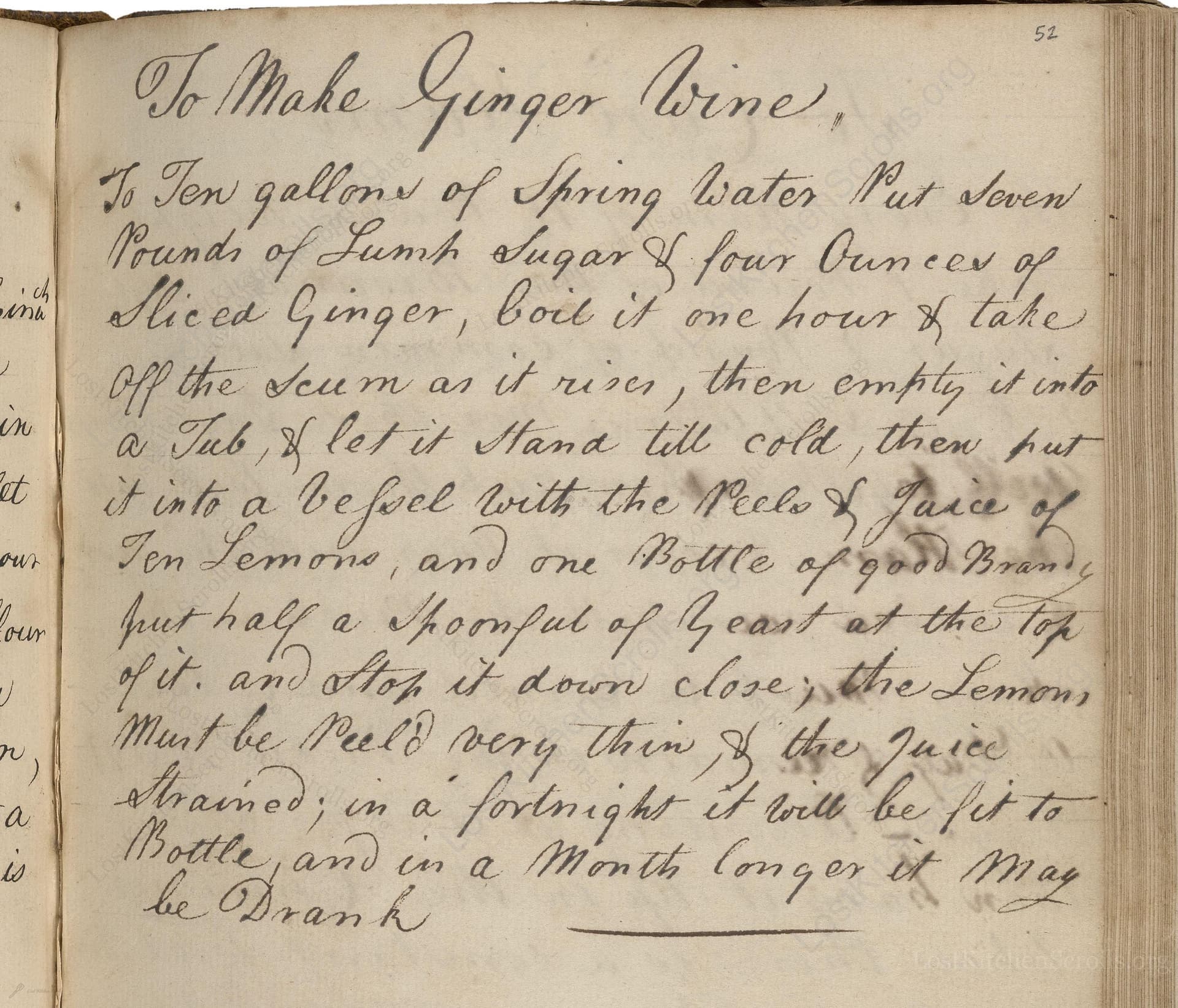To Make Ginger Wine
From the treasured pages of Cookbook of Elizabeth Langley
Written by Elizabeth Langley

To Make Ginger Wine
"To Ten gallons of Spring Water Put Seven Pounds of Lump Sugar & four Ounces of Sliced Ginger, Boil it one hour & take Off the Scum as it rises, then empty it into a Tub & let it Stand till cold, then put it into a Vessel With the Peels & Juice of Ten Lemons, and one Bottle of good Brandy, Put half a Spoonful of Yeast at the Top of it. and Stop it down close; the Lemons, Must be Peel'd very thin & the Juice Strain'd; in a fortnight it Will be fit to Bottle, and in a Month longer it May be Drank"
Note on the Original Text
This recipe is written in the intuitive, conversational style common before standardization of culinary instructions. Quantities are large, befitting a household scale production, and times are approximate ('a fortnight', 'in a month'). Spelling is reflective of the period, e.g., 'Peel'd', 'Stand', 'Stop it down close'. Technical instructions rely on the cook’s experience, such as 'take Off the Scum as it rises' and covering 'close' for fermentation. Measurements like 'half a Spoonful of Yeast' are imprecise and intended for a user comfortable improvising within broad bounds.

Title
Cookbook of Elizabeth Langley (1757)
You can also click the book image above to peruse the original tome
Writer
Elizabeth Langley
Era
1757
Publisher
Unknown
Background
Step into the Georgian kitchen with Elizabeth Langley's 1757 culinary collection, where refined techniques and delightful recipes await those with a taste for historic gastronomy.
Kindly made available by
Folger Shakespeare Library
This ginger wine recipe hails from the mid-18th century, authored by Elizabeth Langley in 1757. At this time in England, the art of home-brewing was still very much alive, and ginger wine was a popular homemade cordial, especially valued during cold seasons. The use of lemons and ginger not only imparted flavor, but were also believed to have health benefits. Wine, beer, and 'small beers' were often made at home for both everyday drinking and festive occasions. Langley’s recipe reflects the pro-active, practical approach of women managing household provisions—a testament to the vital role women played in the culinary and medicinal brewing traditions of their time.

A large copper or iron kettle was set over an open hearth or range for boiling the water, sugar, and ginger. After boiling, the liquid would be transferred into a wooden or earthenware fermentation tub—sometimes called a 'stand' or 'cask'. Hand tools included wooden spoons or paddles for stirring, a sharp knife for peeling lemons, and muslin cloths for straining juice. The vessel would be covered with a cloth (later, corked tightly) to allow gentle fermentation and prevent contamination. Bottling was done into glass bottles with corks and wax for sealing.
Prep Time
30 mins
Cook Time
1 hr
Servings
210
We've done our best to adapt this historical recipe for modern kitchens, but some details may still need refinement. We warmly welcome feedback from fellow cooks and culinary historians — your insights support the entire community!
Ingredients
- 10 gallons spring water
- 7 lb white granulated sugar
- 4 oz fresh ginger root, sliced
- 10 lemons (zest peeled very thinly, juice strained)
- 1.5 pints (3 cups) good brandy
- 1/4 oz baker's yeast (or wine yeast as substitute)
Instructions
- To make Ginger Wine, begin by bringing 10 gallons of spring water to a boil in a large pot.
- Add 7 pounds of white granulated sugar and 4 ounces of fresh ginger, sliced thinly.
- Boil for one hour, skimming off any froth or scum that rises to the top.
- Once boiled, pour the hot liquid into a sanitized fermenting tub and allow it to cool completely.
- Next, prepare the zest and juice of 10 lemons—be sure to peel the lemons thinly so only the yellow layer is used, and strain the juice to remove seeds.
- Add both zest and juice to the cooled liquid, followed by 1.5 pints (3 cups) of quality brandy.
- Stir well.
- Sprinkle approximately 1 tablespoon (about 1/4 ounce) of fresh baker's yeast onto the surface of the liquid.
- Cover the vessel securely so it is air-tight but allows slight venting of gas (using a fermentation airlock is ideal).
- Leave to ferment in a cool, dark place for 2 weeks.
- At that point, carefully siphon the wine into bottles, leaving sediment behind.
- After a month of aging in bottles, your ginger wine is ready to be enjoyed.
Estimated Calories
110 per serving
Cooking Estimates
It takes about 1 hour to cook the ginger and sugar and about 30 minutes to prepare the lemons and ingredients. The recipe makes about 42 standard 750 ml wine bottles. Each bottle gives about 5 servings, so you'll get about 210 servings. Each serving is about 110 calories, based on the sugar, alcohol, and lemon juice used.
As noted above, we have made our best effort to translate and adapt this historical recipe for modern kitchens, taking into account ingredients nowadays, cooking techniques, measurements, and so on. However, historical recipes often contain assumptions that require interpretation.
We'd love for anyone to help improve these adaptations. Community contributions are highly welcome. If you have suggestions, corrections, or cooking tips based on your experience with this recipe, please share them below.
Join the Discussion
Rate This Recipe
Dietary Preference

Den Bockfisch In Einer Fleisch Suppen Zu Kochen
This recipe hails from a German manuscript cookbook compiled in 1696, a time whe...

Die Grieß Nudlen Zumachen
This recipe comes from a rather mysterious manuscript cookbook, penned anonymous...

Ein Boudain
This recipe comes from an anonymous German-language manuscript cookbook from 169...

Ein Gesaltzen Citroni
This recipe, dating from 1696, comes from an extensive anonymous German cookbook...
Browse our complete collection of time-honored recipes



